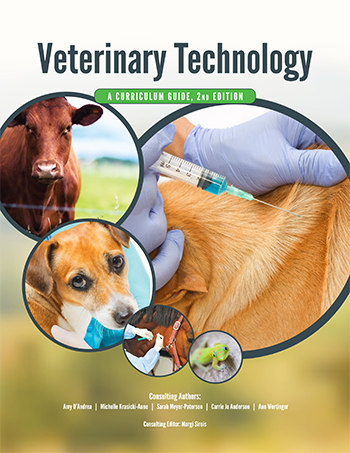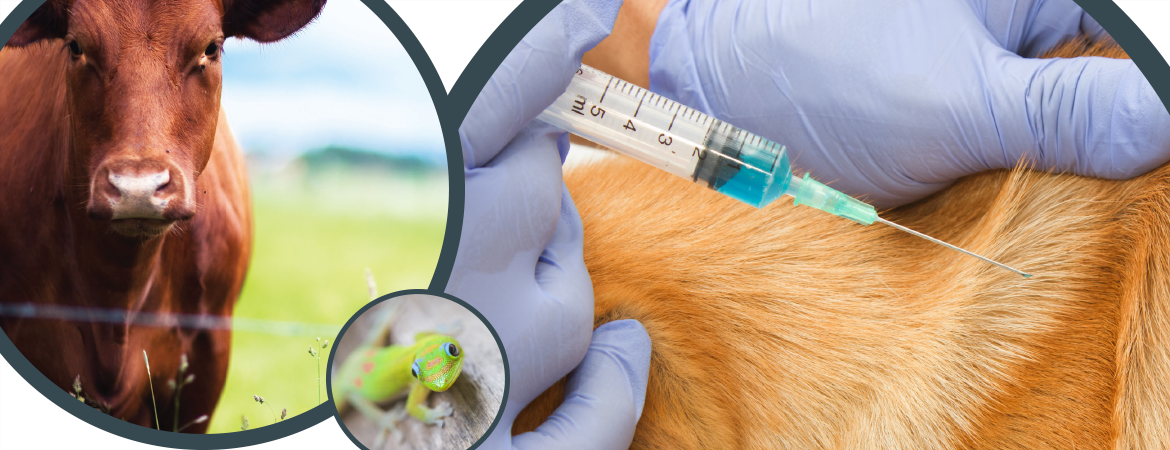
Veterinary Technology Curriculum Guide
This new approach to Vet Tech education will reduce costs and improve student outcomes!
Veterinary Technology Essentials is the latest text from bluedoor. It presents a modular approach for veterinary technology programs, which allows educators to use the textbook as-is, or modify and rearrange the modules to suit their current curriculum. The text consists of 18 modules, combining essential material into one publication, which greatly reduces institutions’ textbook costs. Veterinary Technology Essentials also includes Student Activities, Instructor Resource Guide, PowerPoints, online Question Banks, and instructional videos to streamline the integration of this piece into any curriculum.
Veterinary Technology Essentials can also include the Dog Anatomy – A Photo Atlas by Heather P. Walker, Ph.D. and the Cat Anatomy and Dissection Guide by Bruce Wingerd, Ph.D.
Please note this product is customized to an institution's curriculum and therefore a minimum purchase of 400 units is required.
Table of Contents
- Module 1: Introduction to Veterinary Technology and Animal Restraint
- The Veterinary Technician’s Role: Past, Present, and Future—A Historical View
- Word Parts
- Restraint Techniques for Companion Animals
- Patient History and Physical Examination
- Module 1 Review Exercises
- Module 2: Anatomy and Physiology
- Introduction to Cellular Anatomy and Physiology
- Mammalian Cellular Anatomy & Physiology
- Anatomy of the Musculoskeletal System
- Anatomy of the Circulatory System
- Anatomy of the Respiratory System
- Anatomy of the Digestive System
- Anatomy of the Urogenital System
- Special Senses & Nervous System
- Hematology: Blood and Lymph
- Integumentary System & Endocrine System
- Dissection: Principles & Techniques
- Reptiles and Amphibians
- Avian Anatomy
- Pocket Pets
- Module 2 Review Exercises
- Module 3: Nutrition
- Basics of Nutrition
- Nutritional Support in Disease
- Module 3 Review Exercises
- Module 4: Animal Behavior
- Domestication, Communication, and Socialization
- Behavior: Normal vs Abnormal
- Learning Theories
- Behavior Review
- Module 4 Review Exercises
- Module 5: Veterinary Nursing
- Basic Nursing Principles
- Nursing Principles for the Ill Patient
- Nursing Principles for the Medical Patient: Diagnostics
- Nursing Principles for the Medical Patient: Therapeutics
- Nursing Principles of Special Populations
- Fluid Therapy and Advanced Monitoring
- Dentistry
- Module 5 Review Exercises
- Module 6: Medical Math
- Basic Mathematic Principles for Veterinary Technicians
- Conversions between Measurement Systems
- Dilutions
- Module 6 Review Exercises
- Module 7: Pharmacy and Pharmacology
- Introduction to Pharmacy & Pharmacology
- Dosage Calculations
- Pharmacokinetics
- Veterinary Drug Use: Prescribing, Acquisition, and Pharmacy Management
- Drugs Affecting the Cardiovascular, Respiratory, and Urinary Systems
- Hormones/Reproductive Drugs and Antiparasitics/Gastrointestinal System Drugs
- Musculoskeletal System Drugs/Anti-Inflammatories and Analgesics/Emergency Drugs
- Antimicrobials, Anti-neoplastic, and Immunosuppressive Drugs
- Module 7 Review Exercises
- Module 8: Diagnostic Technologies
- Radiation Science and Image Development
- Radiographic Techniques
- Radiography of the Pelvis, Shoulder, Extremities, Skull, and Spine
- Special Imaging Studies
- Exotic Animal Imaging and Alternate Imaging Techniques
- Module 8 Review Exercises
- Module 9: Veterinary Laboratory Techniques
- Laboratory & Pathology Terminology/Laboratory Safety/Microscope Applications
- Hematology Practice and Identification
- Erythrocyte Indices and Corrected White Blood Cell Count Calculations
- Hemostasis
- Urinalysis
- Cytology
- Clinical Chemistry Equipment
- Commonly Performed Clinical Chemistry Tests
- Immunology Testing And Acid-Base Balance
- Transfusion Medicine
- Diagnostics Testing in Exotic Animals
- Module 9 Review Exercises
- Module 10: Parasitology
- Terminology and Common Diseases
- External & Internal Parasite Identification
- Internal & Intestinal Parasite Identification Techniques
- Module 10 Review Exercises
- Module 11: Microbiology
- Introduction to the Laboratory & Microbiology
- Bacteriology—Culture & Testing for Identification
- Mycology
- Module 11 Review Exercises
- Module 12: Animal Diseases
- Zoonoses, Epidemiology, and Preventive Medicine
- Pansystemic Diseases
- Diseases of the Respiratory and Cardiovascular Systems
- Dermatology
- Diseases of the Urinary System and Ophthalmology
- Endocrinology and Oncology
- Hematologic Diseases
- Musculoskeletal and Nervous System Diseases and Genetic Disorders
- Reproductive Diseases and Toxicology
- LDiseases of the Gastrointestinal Tract, Liver Diseases
- Module 12 Review Exercises
- Module 13: Veterinary Anesthesia
- Introduction to Anesthesia/Patient Preparation
- Anesthetic Agents and Pain Management
- Anesthesia Equipment/Anesthetic Monitoring
- Cat and Dog Anesthesia/Equine Anesthesia
- Anesthetic Problems and Emergencies/Workplace Safety
- Module 13 Review Exercises
- Module 14: Office and Hospital Management
- Veterinary Health Care Team/Human Resource Management
- Receptionist Team/Client Communication
- Marketing/Legal/Appointments/Medical Records
- Inventory, Accounting, and Occupational Safety
- Practice Design and Technology in the Office
- Module 14 Review Exercises
- Module 15: Veterinary Surgical Nursing
- Pre-operative Period
- Surgical Assisting and Pain Management
- Post-Operative Period
- Common Surgical Procedures
- Aseptic Technique
- Module 15 Review Exercises
- Module 16: Large and Farm Animal Care
- Introduction to Large Animal Care and Nutrition
- Equine Husbandry and Clinical Procedures
- Bovine Husbandry and Clinical Procedures
- Sheep and Goat Hubandry and Clinical Procedures
- Swine Husbandry and Clinical Procedures
- Equine Emergencies
- Module 16 Review Exercises
- Module 17: Veterinary Emergency and Critical Care
- Triage
- Vascular Access/Fluid Therapy/Acid-Base Balance
- Common Emergencies
- Wound Management
- Module 17 Review Exercises
- Module 18: Laboratory and Exotic Animals
- Introduction to Laboratory Animal Medicine
- Mice, Rats, and Guinea Pigs
- Hamsters, Gerbils, Ferrets, Rabbits, and Nonhuman Primates
- Avian and Reptile Medicine
- Issues Related to Wild Animals and Zoo Animals
- Emergency Care of Wildlife and Exotic Animals
- Module 18 Review Exercises
Textbook
Student Activities
Online Interactive Activities Demo Video
PAR (Practical Assessment & Review) Demo Video
Question Bank Samples
Procedural Videos
Videos available:
- Equine halter and lead
- Equine oral medication (syringe)
- Equine jugular blood collection
- Equine intramuscular injections
- Equine TPR
- Equine pick feet
- Equine leg and tail wraps
- Bovine halter
- Bovine oral medication (balling gun)
- Bovine tail restraint (tail jack)
- Bovine coccygeal venipuncture
- Bovine intramuscular injections
- Bovine restraint
- Canine cephalic vein intravenous catheter placement
- Canine Modified Robert Jones bndg
- Canine blood collection (jugular)
- Canine subcutaneous injection
- Canine Intramuscular injection
- Canine Physical Exam
- Canine and Feline oral med
- Feline restraint
- Feline subcutaneous injection
- Feline Intramuscular injection
- Feline Physical Exam
- Performing an ECG
- IV injection (cephalic and saphenous)
- Catalase test
- Coagulase test
- Cytology roll prep
- Urine sediment prep
- Refractometer
- Blood film preparation
- Closed Gloving
- Direct Drop Microfilaria
- Donning a Sterile Surgical Gown
- Esophagostomy tube placement
- Hand Drying
- Manual Differential technique
